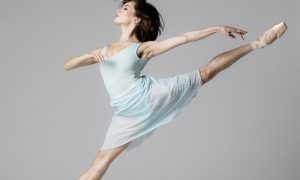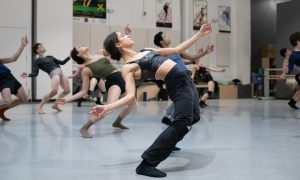When one imagines a post-modern artist, it’s most likely that not the most social of creatures comes to mind. It’s more likely someone who’s consumed with creative process, and as a result is a bit disconnected from the concerns of the average Joe or Jane. Some artists, however, demonstrate equal commitment to both their artistic work and enhancing their surrounding society at large.
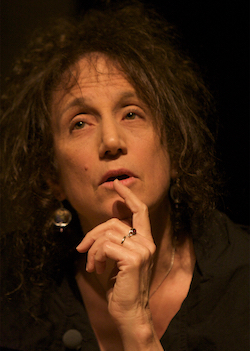
Liz Lerman. Photo by JS Rosenthal.
That description fits Liz Lerman to a T, at once the “Democrat of Dance” and with work of “expansive range, emotional depth and singular beauty” (Alan M. Kriegsman and Sarah Kaufman, respectively, The Washington Post). This past March, Jacob’s Pillow Dance announced it has granted Lerman the 2017 Jacob’s Pillow Dance Award. The honor includes $25,000 in Jacob’s Pillow commissions, presentations and the Creative Development Residency Program.
Past recipients include Merce Cunningham, Kyle Abraham, Bill T. Jones, Crystal Pite and Camille A. Brown. For Lerman, the award is “casting a light on a larger set of ideas” that her career has represented – including learning environments, the place of artists as citizens, and the capacity of dance performance to address such concrete topics as history, politics and science.
“I hope what the Pillow is saying to me is we have respected your willingness to push boundaries, and we expect and need that to continue,” says Lerman. Indeed, the Pillow states that they are granting her the award because of her “massive contributions to the dance field, including important research around public inclusion and community engagement.” Lerman first presented work at the Pillow in 1985’s Inside/Out Festival, and has maintained close ties with the site since then. She speaks fondly of the Pillow, where she has returned on numerous occasions since, as an important artistic home.
Outside of the Berkshires, in 2016, she assumed a new university position as Institute Professor with the Herberger Institute for Design and the Arts of Arizona State University (ASU). Her influence there spans from dance and theater to media design. “The use of new technologies is a central part of her work from 1984 to the present, showing a huge range of study from shipyards, to genetics, to the Large Hadron Collider at CERN,” explains the Pillow’s press release.
Since moving to Arizona, Lerman has also been intrigued by the traditional and contemporary work of artists from cultures prevalent in the southwest. She looks forward to further engaging with choreographers in these forms. In striking humility for a dancemaker of such renown, she asserts, “They’re not emerging….I’m emerging!”, adding that she is gaining as much as she is offering in conversations about the relationship between postmodernism and indigenous values. Reinforcing this wide and culturally-inclusive viewpoint, she explains how “the books perpetuate what the history ‘is’; [dance history] is not all [concert dance].”
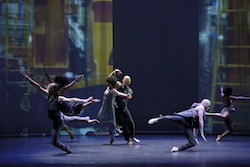
Liz Lerman’s ‘The Matter of Origins’. Photo by Mike Peters.
Lerman has been reaching across not only artistic media and styles but also disciplines. That builds on art/science collaborations over the course of the last 15 years in which she has created stage works addressing genetics, physics, and the relationship between warfare and medicine. Bringing insight from such work to ASU, Lerman is currently leading Animating Research, a course in which arts students are collaborating with biodesign researchers to give vital expression to recent findings in a cutting-edge science field.
Choreographer of almost 100 works for the stage and site-specific settings, Lerman also continues to develop provocative performance projects. Her newest is the tentatively titled Wicked Bodies. Its inspiration is an exhibit she encountered in Edinburgh featuring 500 years of art depicting witches. Often hideous and vilifying, the images struck Lerman as “a reaction to the threat of a woman holding power.” On one level, the project is quite timely, given current events re-igniting heated dialogue on women’s bodies and how they deserve to be in the world.
On another level, these issues and accompanying questions are timeless ones. “What makes a woman a witch?” Lerman asks. “How do a woman’s activities become criminalized?” Just as timeless of a consideration, she also discusses art and spirituality. She explains how spirituality is not a common area for exploration in post-modern art, and is even sometimes there maligned. “What forms the borders, the taboo; what made art not spiritual?” she probes.
Also sometimes rejected in post-modern art are the use of tools, says Lerman – such as structures for shaping improvisation and methods for diversifying a single movement phrase. There can be a deep philosophical stance that tools narrow one’s explorations, and thus potential output, she explains. Yet they “sharpen and frame the imagination,” Lerman asserts. Through that, tools give new “rooms to explore”, as well as “personalize” such exploration.
In dance, this process and their components – the tools, what they shape, et cetera – are “not always physical,” she adds. They can be new ways of thinking, solving problems and engaging with other artistic media. Through writing, web projects, workshops and master classes, Lerman has sought numerous avenues over the years for sharing such approaches. With colleagues at ASU, her newest enterprise on this front is Atlas of Creative Tools, which will use an online learning platform to record, codify and disseminate these perspectives on using tools in the creative process.
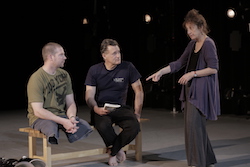
Liz Lerman (right) and ‘Healing Wars’. Photo courtesy of Lerman.
Lerman’s text Hiking Horizontal: Field Notes From A Choreographer (2011, Wesleyan Press) similarly puts in writing the wisdom that her prolific, commendable career has generated, as well as a look into her intuitive sense that is behind it all. It’s a memoir, of sorts, of her artistic life and associated perspectives. One particular reader’s reaction has resonated with her.
Vijay Gupta, a violinist with the Los Angeles Philharmonic, emailed her saying that one line in particular deeply affected him, even altering how he approaches his creative work: “I’m not fragmented, but the world is.” Lerman was quite pleased, she shares, that something in her book affected a fellow artist in such a way. On the other hand, she says, “I wrote the book mainly for people who may not identify as artists” but instead to give them greater insight into creative process, and thus perhaps be better equipped to beneficially enact their own creativity.
This instance exemplifies a key quality of Lerman’s life’s work – influential for art and other artists, yet catalyzing conversations and actions beyond the artistic sphere. Jacob’s Pillow, an important preserver of dance history and agent in the art form’s ongoing course, has recognized and honored her for this. May we continue to do the same by furthering her legacy of creative exploration that can touch the lives of all.
By Kathryn Boland of Dance Informa.






